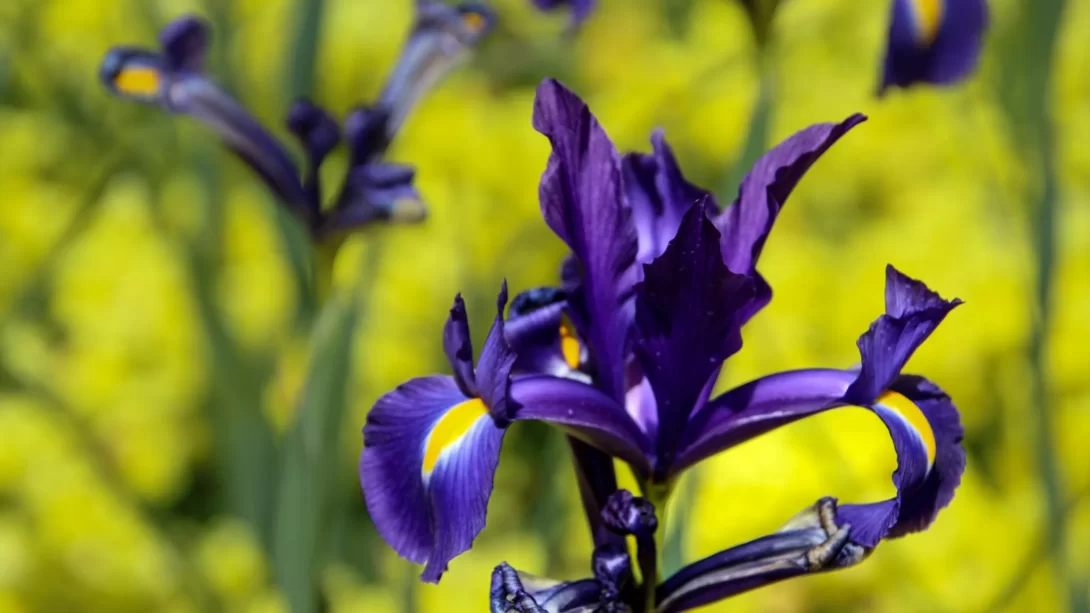Irises, with their striking beauty and variety of colors, are a favorite among gardeners. These perennials add a vibrant touch to any garden, but sometimes they disappoint by not blooming. Understanding the reasons behind this can help gardeners encourage their irises to flourish.
Irises
Irises come in many varieties, each with unique blooming characteristics. From the bearded iris, known for its fuzzy “beards,” to the sleek Japanese iris, these plants typically bloom in late spring to early summer. The growth cycle of irises involves a period of dormancy in winter, followed by a growth spurt in spring that leads to blooming.
Common Reasons for Non-Blooming
Improper Planting Depth
One of the most common reasons for irises not blooming is incorrect planting depth. Irises need to be planted at the right depth to thrive. For bearded irises, the rhizome (the horizontal stem from which roots grow) should be partially exposed, while most other varieties require deeper planting. The general rule is to plant the rhizome about an inch below the soil surface.
Inadequate Sunlight
Sunlight plays a crucial role in the blooming of irises. These flowers require at least half a day of direct sun to produce their best blooms. If planted in too much shade, irises will struggle to flower. Assessing and adjusting the planting location can sometimes be all that’s needed to encourage blooming.
Overcrowding
Over time, iris clumps become crowded, which can impede their ability to bloom. Crowded conditions lead to competition for nutrients and sunlight. To prevent this, it’s recommended to divide irises every three to five years. Dividing them involves gently separating the rhizomes and replanting them with adequate space for growth.
Nutrient Imbalance
The right balance of nutrients is essential for irises to bloom. An excess of nitrogen can lead to lush foliage at the expense of flowers, while a deficiency in phosphorus can hinder blooming. Conducting a soil test can provide valuable insights into your soil’s nutrient profile. Based on the results, you can amend the soil with appropriate fertilizers. A balanced 10-10-10 fertilizer applied in early spring can promote healthy blooms in irises.
Watering Issues
Watering is a delicate balance for irises. While they need a consistent supply of moisture, especially during the growing season, overwatering can lead to root rot, a common problem that inhibits blooming. Conversely, underwatering can stress the plant, leading to poor or no blooms. The ideal watering routine involves keeping the soil moist but not soggy, allowing the top inch of soil to dry out between waterings.
Climate and Weather Conditions
The local climate and unexpected weather patterns can significantly affect iris blooming. Irises generally prefer a temperate climate with a clear distinction between the seasons. In areas with very mild winters, irises may not receive the necessary chilling period to trigger blooming. Conversely, late frosts can damage emerging buds. Gardeners should choose iris varieties suited to their local climate and be prepared to protect plants from unusual weather events.
Pest and Disease Problems
Pests and diseases can also prevent irises from blooming. Common culprits include iris borers, which damage the rhizomes, and fungal diseases like leaf spot and root rot. Regular inspection of plants for signs of pests and disease is crucial. Infected parts should be removed and destroyed, and appropriate fungicides or insecticides can be used as a preventive measure. Maintaining good garden hygiene, such as removing debris and avoiding overcrowding, can also help prevent these issues.
Age of the Plant
The age of the iris plant can influence its blooming. Newly planted irises often take a year or two to establish themselves before they start blooming. On the other end of the spectrum, very old iris clumps can become less vigorous and may need rejuvenating through division. Understanding the life cycle of your irises can help set realistic expectations for blooming.
Maintenance Practices
Proper maintenance is key to ensuring your irises bloom year after year. Regular pruning helps to keep plants healthy. Remove any dead or diseased foliage, and after blooming, cut back the flower stalks to the base to prevent seed formation, which can divert energy from the rhizome. In fall, a light trimming of leaves can help prevent overwintering pests and diseases.
Deadheading, the removal of spent flowers, not only keeps your iris beds looking tidy but also encourages the plant to focus its energy on root and rhizome development rather than seed production. This practice is especially beneficial for repeat blooming varieties.
Preparing irises for winter is also crucial, particularly in colder climates. While irises are generally hardy, a layer of mulch can help protect the rhizomes from freezing temperatures. However, be sure to remove the mulch in early spring to prevent rot.
Troubleshooting Tips
If your irises are still not blooming despite addressing the above factors, consider these troubleshooting tips:
- Reevaluate the Location: Sometimes, what was once a sunny spot can become shaded due to tree growth or new constructions. Consider relocating your irises to a sunnier spot.
- Check for Signs of Stress: Look for symptoms like discoloration, spots on leaves, or stunted growth, which can indicate pest infestations or diseases.
- Soil Reassessment: If it’s been a few years since your last soil test, it might be time for another. Soil conditions can change over time, affecting nutrient availability.
- Be Patient: Remember that some irises take time to establish and bloom, particularly if they were recently divided or transplanted.
- Seek Expert Advice: If all else fails, consult a local horticulturist or a gardening center for personalized advice tailored to your specific situation and local environment.
Conclusion
Irises can be a stunning addition to any garden, but they do require specific conditions to bloom beautifully. By understanding their needs and addressing issues like planting depth, sunlight, watering, and nutrients, you can encourage your irises to produce their stunning flowers each year. Remember, gardening is a journey of learning and patience, and the rewards of seeing your irises in full bloom are well worth the effort.




